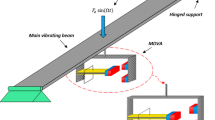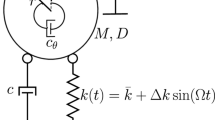Summary
Nonlinear excitations cause angular vibrations in torsional strings. In long strings, the vibrations are characterized by different dynamic behavior over the length. For a general case of a long torsional string, a simplified mathematical model is introduced and numerically simulated. In order to gain insight into the complex spatio-temporal dynamics, the method of proper orthogonal decomposition is applied. A short description of this powerful technique for continuous as well as discrete systems follows. By proper orthogonal decomposition, the dynamic response is projected on a subset of the state space in which the most dominant dynamic effects take place. The time-invariant eigenfunctions represent the most persistent structures in the system. By this method the eigenfunctions of long torsional strings are investigated. The reduction of the system's dimension as well as the approximation of the system state is presented.
Similar content being viewed by others
References
Armbruster, D.: Analyzing spatio-temporal complexity. In: Kreuzer, E.; Schmidt, G. (eds.) 1st European Nonlinear Oscillations Conference, pp. 1–21. Berlin: Akademie Verlag 1993
Aubry, N.;Guyonnet, R.;Lima, R.: Spatiotemporal analysis of complex signals: Theory and applications. J. Stat. Phys. 64 (1991) 638–739
Berkooz, G.;Holmes, P.;Lumley, J.L.: The proper orthogonal decomposition of turbulent flows. Annu. Rev. Fluid Mech. 25 (1993) 539–575
Finnie, I.;Bailey, J. J.: An experimental study of drill-string vibration. Trans. ASME Ser. B: J. Eng. Indust. 82 (1960) 129–135
Golub, G. H.;Van Loan, Ch. F.: Matrix computations (2nd eed.) Baltimore: The Johns Hopkins University Press (1989)
Karhunen, K.: Zur Spektraltheorie stochastischer Prozesse. Ann. Acad. Sci. Fenn. Series A-I.Mathematica 34 (1946)
Karhunen, K.: Über lineare Methoden in der Wahrscheinlichkeitsrechnung. Ann. Acad. Sci. Fenn. Series A-I. Mathematica 37 (1947)
Kirby, M.;Armbruster, D.: Reconstructing phase space from pde simulations. Z. Angew. Math. Phys. 43 (1992) 999–1022
Kreuzer, E.: Numerische Untersuchung nichtlinearer dynamischer Systeme Berlin: Springer 1987
Loève, M.: Functions aléatoires de second ordre. C. R. Acad. Sci. 220 (1945)
Loève, M.: Probability theory (4th ed.) New York: Springer 1978
Sirovich, L.: Turbulence and the dynamics of coherent structures. Part I–III. Quart. Appl. Math. 45 (1987) 561–590
Smith, G. D.: Numerical solution of partial differential equations: Finite difference methods. Oxford: Clarendon Press 1985
Troger, H.;Steindl, A.: Nonlinear stability and bifurcation theory. New York: Springer 1991
Vemuri, V.;Karplus, W. J.: Digital computer treatment of partial differential equations. Englewood Cliffs: Prentice-Hall 1981
Author information
Authors and Affiliations
Rights and permissions
About this article
Cite this article
Kreuzer, E., Kust, O. Analysis of long torsional strings by proper orthogonal decomposition. Arch. Appl. Mech. 67, 68–80 (1996). https://doi.org/10.1007/BF00787141
Received:
Accepted:
Issue Date:
DOI: https://doi.org/10.1007/BF00787141




